A Mirror Built for Space
The Story of the James Webb Space Telescope’s Primary Mirror
How do you design a mirror with a diameter of 6.5 meters that can survive a rocket launch into space, orbit the Earth at a radius of about one million miles for 5-10 years, and hold its shape at temperatures near -220˚C? And why would you want to?
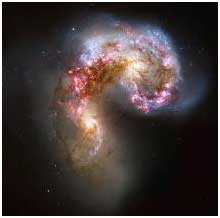
A Hubble image of the two Antennae Galaxies, which started to interact a few hundred million years ago.
Credit:NASA, ESA, and the Hubble Heritage Team (STScI/AURA)-ESA/Hubble Collaboration
Acknowledgment: B. Whitmore (Space Telescope Science Institute)
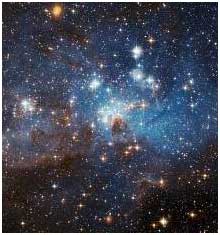
A Hubble image of a bluish nebula expanding out into the remains of the molecular cloud that collapsed to form the massive stars in this region.
Credit:NASA, ESA, and the Hubble Heritage Team (STScI/AURA)-ESA/Hubble Collaboration
Acknowledgment: D. Gouliermis (Max Planck Institute for Astronomy, Heidelberg)
The Hubble Space Telescope has been capturing imaginations for more than 20 years, with stunning pictures of intertwined galaxies and up-close views of regions where new stars are being born. The Hubble has revealed all kinds of things about the universe, including the vibrant activity taking place in the deepest, darkest regions of the night sky. But before the Hubble ever recorded an image, before it even left the ground, astronomers were already dreaming about the next generation telescope that would be its successor.
The successor to the Hubble, the James Webb Space Telescope (JWST, named after the man who ran NASA from 1961-1969), will be an amazing scientific and technological feat. This telescope will detect light coming from the first galaxies ever formed, about 13 billion years ago.
Check out this trailer for the project:
Building an instrument with this capacity requires LOTS of people, time, money, and innovation. Planning began as early as 1989, the year before the Hubble was launched into orbit around the Earth, and JWST is expected to launch in 2018—some 30 years later.
The Hubble Space Telescope is sensitive to visible light, like the human eye, but JWST will be most sensitive to infrared light. All warm objects give off infrared light (in the form of heat)—even JWST. This would not be a problem if the telescope was looking at an intense source of infrared light, but it will be looking at such distant objects that it will see only very faint signals. In fact, the infrared light from the sun and from the electronics on JWST could easily overwhelm the light signals that it is meant to detect. To avoid this, JWST was designed so that the Sun, Earth and Moon are always on the same side of the system, and the mirror and the detectors are protected from them with a large sunshield.
One of JWST’s most captivating elements is a giant, futuristic-looking mirror that folds up to fit inside of its launch vehicle (an Ariane 5 ECA provided by the European Space Agency) and unfolds after launch.
This unique design is the result of nearly two decades of planning and construction, and there is still much work to be done before the 2018 launch date. Every part of the telescope has to be carefully designed, constructed, and tested, and there are all sorts of factors to consider for each step.
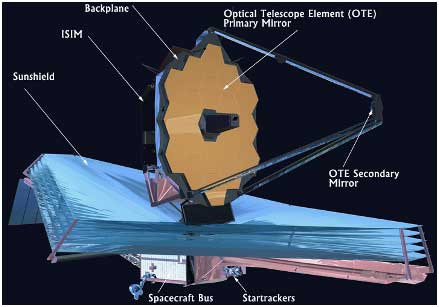 Above: An artist conception of JWST, folded inside of the launch vehicle. Left: An artist conception of JWST, fully deployed. Credit: NASA |
 |
For example, the mirror’s size was determined by the science goals of the project. In order for a telescope to “see” an object, the telescope has to collect enough light from an object to construct an image. There are two ways to increase the light-gathering capacity of a telescope like the Hubble—increase the size of the primary mirror or increase the amount of time the telescope is pointed at an object. In order to “see” light coming from the oldest galaxies, which are around 13 billion light years away, researchers determined that JWST needed a primary mirror with a diameter of at least 6.5 meters.
The mirror also has to be light and small enough to ride inside of a space launch vehicle. One of the main reasons that the Hubble telescope is so valuable is that it is outside of the Earth’s atmosphere. Light coming from a celestial object to a ground-based telescope is distorted as it travels through the gases in the Earth’s atmosphere. This distortion has to be eliminated in order to see distant galaxies, and the best way to do that is to put the telescope in space!
Another requirement is that JWST’s mirrors keep their shape at very cold temperatures, up to -240˚C, since JWST will be operating in deep space for an estimated 5-10 years, and maybe more.
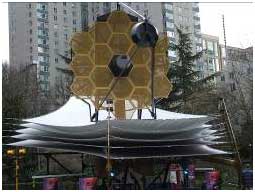
A full-scale model of JWST at the American Astronomical Society Meeting in Seattle, January 2007.
Credit: NASA
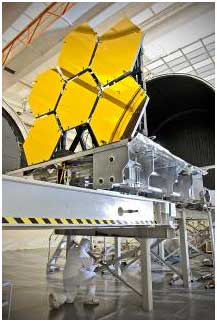
The first six flight ready James Webb Space Telescope's primary mirror segments are prepped to begin final cryogenic testing at NASA's Marshall Space Flight Center in Huntsville, Ala.
Credit: Chris Gunn, NASA
These are just a few of the factors that went into designing JWST’s unique primary mirror. The final design for the mirror consists of 18 hexagonal segments, each weighing about 20 kg. Each segment is controlled by small motors and can move up and down, left to right, and back to front, which is necessary for unfolding and focusing the mirror. The curvature of each segment can also be adjusted.
The hexagonal shape of each segment is important for a few reasons.
- The segments create an overall circular shape, which is effective for focusing the light into a small.
- The symmetry simplifies the optics. Among the 18 segments, there are three groups of six segments that all have identical shapes and other parameters. (More information)
- The segments fit together seamlessly when they are aligned.
The segments are made from beryllium, a light, strong metal that can hold its shape across a range of temperatures. Once the mirror segments are molded and shaped, they are polished to exact specifications, to within an error less than one millionth of an inch. Finally, they are coated with a thin layer of gold, which is more reflective than beryllium. At various points along this multi-step process the mirrors are tested to ensure that they will stand up to the harsh conditions.
From the beryllium mine in Utah to the launch pad in Kourou, French Guiana, constructing the segments takes more than 14 stops at 11 different locations. And all of that is just for JWST’s primary mirror!
For more information on the James Webb Space Telescope and its science, visit:
The James Webb Space Telescope
Find out more about the JWST on its website.
Webb Science
Explore JWST’s science goals.
NASA: James Webb vs Hubble
Learn about the differences between the Hubble Space Telescope and the James Web Space Telescope.
The Primary Mirror
Explore the primary mirror in more detail with this NASA article.
NASA: Final Polishing Complete
Read about the intense task of polishing the JWST mirrors to their exact shape, with an error of less than one millionth of an inch.














